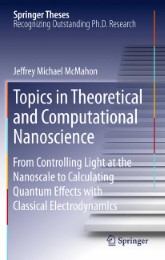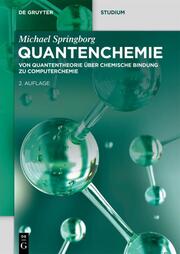Topics in Theoretical and Computational Nanoscience
eBook - From Controlling Light at the Nanoscale to Calculating Quantum Effects with Classical Electrodynamics, Springer Theses
Bibliographische Informationen
Format: PDF
Digitale Rechteverwaltung: Digitales Wasserzeichen
Beschreibung
Interest in structures with nanometer-length features has significantly increased as experimental techniques for their fabrication have become possible. The study of phenomena in this area is termed nanoscience, and is a research focus of chemists, pure and applied physics, electrical engineers, and others. The reason for such a focus is the wide range of novel effects that exist at this scale, both of fundamental and practical interest, which often arise from the interaction between metallic nanostructures and light, and range from large electromagnetic field enhancements to extraordinary optical transmission of light through arrays of subwavelength holes.
This dissertation is aimed at addressing some of the most fundamental and outstanding questions in nanoscience from a theoretical and computational perspective, specifically:
· At the single nanoparticle level, how well do experimental and classical electrodynamics agree?
· What is the detailed relationship between optical response and nanoparticle morphology, composition, and environment?
· Does an optimal nanostructure exist for generating large electromagnetic field enhancements, and is there a fundamental limit to this?
· Can nanostructures be used to control light, such as confining it, or causing fundamentally different scattering phenomena to interact, such as electromagnetic surface modes and diffraction effects?
· Is it possible to calculate quantum effects using classical electrodynamics, and if so, how do they affect optical properties?
Inhalt
INTRODUCTION.- BASIC ELECTROMAGNETIC THEORY.- THEORETICAL AND COMPUTATIONAL METHODS.- CORRELATED SINGLE-NANOPARTICLE CALCULATIONS AND MEASUREMENTS.- OPTIMAL SERS NANOSTRUCTURES.- NANOSTRUCTURED METAL FILMS.- OPTICAL CORRALS.- CONCLUSIONS AND OUTLOOK.- DRUDE PLUS TWO LORENTZ POLE (D2L) DIELECTRIC MODEL PARAMETERS.- DERIVATION OF THE FINITE-ELEMENT FUNCTIONAL.- DERIVATION OF THE HYDRODYNAMIC DRUDE MODEL.- DERIVATION OF NONLOCAL FINITE-DIFFERENCE EQUATIONS.-
E-Book Informationen
Um die PocketBook Cloud zu aktivieren, loggen Sie sich bitte in Ihrem Kundenkonto ein und gehen dort in den Bereich „E-Books“. Setzen Sie hier einen Haken bei „Neue E-Book-Käufe automatisch zu meiner Cloud hinzufügen.“. Dadurch wird ein PocketBook Cloud Konto für Sie angelegt. Die Zugangsdaten sind dabei dieselben wie die Ihres Kundenkontos in diesem Webshop.
Weitere Informationen zur PocketBook Cloud finden Sie unter www.meinpocketbook.de.
Allgemeine E-Book-Informationen
E-Books in diesem Webshop können in den Dateiformaten EPUB und PDF vorliegen und können ggf. mit einem Kopierschutz versehen sein. Sie finden die entsprechenden Informationen in der Detailansicht des jeweiligen Titels.
E-Books ohne Kopierschutz oder mit einem digitalen Wasserzeichen können Sie problemlos auf Ihr Gerät übertragen. Sie müssen lediglich die Kompatibilität mit Ihrem Gerät prüfen.
Um E-Books, die mit Adobe DRM geschützt sind, auf Ihr Lesegerät zu übertragen, benötigen Sie zusätzlich eine Adobe ID und die kostenlose Software Adobe® Digital Editions, wo Sie Ihre Adobe ID hinterlegen müssen. Beim Herunterladen eines mit Adobe DRM geschützten E-Books erhalten Sie zunächst eine .acsm-Datei, die Sie in Adobe® Digital Editions öffnen müssen. Durch diesen Prozess wird das E-Book mit Ihrer Adobe-ID verknüpft und in Adobe® Digital Editions geöffnet.
Weitere Artikel aus der Kategorie "Chemie/Theoretische Chemie"
Lieferbar innerhalb 1 - 2 Wochen

Lieferbar innerhalb 1 - 2 Wochen

Lieferbar innerhalb 1 - 2 Wochen

Lieferbar innerhalb 1 - 2 Wochen

Lieferbar innerhalb 1 - 2 Wochen

Lieferbar innerhalb 1 - 2 Wochen









